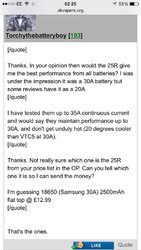You are using an out of date browser. It may not display this or other websites correctly.
You should upgrade or use an alternative browser.
You should upgrade or use an alternative browser.
Two Batteries in Parallel - Twice the Available Current?
- Thread starter concentriccircles
- Start date
TruckinVaper
Achiever
- Joined
- Sep 3, 2014
- Messages
- 1,388
Ok, so I think it's pretty clear who here knows what their talking about, and who (like me) isn't quite up to speed, so thanks to the helpful folks.
Be nice to come to a consensus though. Is a sensible figure to tune the current draw to something like 80 - 90% of the maximum rated discharge for a single cell? And is it ok to work on a doubling of that maximum rated discharge for a parallel setup, or is it the case that although that makes sense on paper it isn't sensible in the real world and you should take a belt and braces approach and stick to the single cell rating?
It isn't the end of the world either way, the setup I'm running these days on a single sell is more than adequate, and a reason to start researching a mod with a LIPO cell is pretty appealing. I'd rather have a safe setup and a new project than no new project and no face or fingers.
I think your heading along the right lines. Barring a connection failure on one of the batteries and presuming your cells are well matched you do have twice the amp draw available. How much your willing to pull from the cells is up to you at the end of the day. Hugget's post previously about Torchy's tests would hold ground for me as he is renowned and trusted. I do have the ability and equipment to check these things out myself along with accurately measuring the internal resistance of the cells to ensure matched cells but don't tend to have the time for things like that these days. Plugging Torchy's figures into steam engine gives you 30% head room on a 0.1ohm build but your talking crazy power there. 176.4W at 42A not accounting for volt drop or 136.9W at 37A at 3.7V nominal voltage. I'd be quite confident in building a set up for that, whether I'd want to is a different matter.
Another thing to bare in mind is even if you did do a build safe for a single cell and then put that onto a parallel setup even though the voltages start off the same the parallel setup would hold it's voltage better under load. This would mean that you'd still get more power and be super safe.
I think there are better ways to get that sort of Wattage if that's what you or anyone else wants. Sticking to 4.2V max your having to build lower and lower resistance to get there, getting closer and closer to a short. It also means that any slight variation makes a huge difference.
In my opinion upping the voltage and upping the resistance is the way to go. There are a few ways to do that to achieve similar power levels but all of them involve taking different precautions and various different build techniques. High power regulated mods are all the rage but they aren't without problems with supplying power to them. Most are powered with two cells in parallel but without a way to monitor each cell individually you would again have to be absolutely sure of your connections. I've heard of a few that ended up running on one cell without the user being aware till they went to charge them.
There are a few regulated mods that will run off series cells I think but not many, this would be the way to go if the electronics are up to scratch. This way both cells could be monitored in use and if a connection fails the power would be lost altogether.
Non regulated series is another way to go but you have to drastically alter the way you build and not many atty's are up to the job. Chegs is the man for this I believe.
Any series setup involves a more complicated charging setup to balance charge the cells. This is an absolute must.
What mod is it your getting by the way? Can the switch handle getting on for 50A?
I hope Torchy is stress testing every battery he uprates to 30A or is working directly with Samsung......
The thing with manufacturer specifications is they guarantee minimum performance. Sure some samples may exceed the spec comfortably, some might not. Specs are based on Friday afternoon samples unless the manufacturer wants to bin a load of products in QA
I routinely run stacked 18350 batteries with a 3ish Ohm coil in an IGO L so you certainly don't need a special atomizer. The advantage is that I can build big coils with small wires giving instant ramp up. In reality at that power level I'd get the same performance from an 18650 with a 0.7 coil but the stacked setup has just sort of stuck
Of course if you want to run a 0.4 ohm coil at 8 volts you'll need something a bit more serious than an IGO-L lol
One last note. Using removable batteries balance charging is no more complicated than putting both batteries in the same charger
On a mechanical mod you can even balance cells on the fly should the fancy take you, though I can't imagine why it would
It's only fixed cells like LiPo packs that require complicated balance charging using "non standard" equipment
I think the 100w SX350 chip will take an 8V input. Certainly one of the YiHi ones does. I think the OKR chips might too. Or maybe I'm thinking of the NAOS chips. I don't really follow the regulated stuff
The thing with manufacturer specifications is they guarantee minimum performance. Sure some samples may exceed the spec comfortably, some might not. Specs are based on Friday afternoon samples unless the manufacturer wants to bin a load of products in QA
I routinely run stacked 18350 batteries with a 3ish Ohm coil in an IGO L so you certainly don't need a special atomizer. The advantage is that I can build big coils with small wires giving instant ramp up. In reality at that power level I'd get the same performance from an 18650 with a 0.7 coil but the stacked setup has just sort of stuck
Of course if you want to run a 0.4 ohm coil at 8 volts you'll need something a bit more serious than an IGO-L lol
One last note. Using removable batteries balance charging is no more complicated than putting both batteries in the same charger
On a mechanical mod you can even balance cells on the fly should the fancy take you, though I can't imagine why it would
It's only fixed cells like LiPo packs that require complicated balance charging using "non standard" equipment
I think the 100w SX350 chip will take an 8V input. Certainly one of the YiHi ones does. I think the OKR chips might too. Or maybe I'm thinking of the NAOS chips. I don't really follow the regulated stuff
sparkyjuice
Achiever
- Joined
- Jan 27, 2014
- Messages
- 3,618
Something that needs to be added is if you are going to pair batteries then BUY them together, KEEP them together and CHARGE them together.
to try and ensure a well matched pair.
to try and ensure a well matched pair.
Chegs
Veteran
- Joined
- Sep 15, 2013
- Messages
- 5,816
My fave vaping device lately is back on 4.2 volts,as it's a squonker & I just modified a previous build to create it.I still have an 8.4 volt box mod running,but it only gets used for an hour or so daily when the squonker is recharging.
They both use lipo packs as I got pissed off with all the fake 18xxx/26xxx cells appearing.There are some 22 mm attys that can accommodate the quantities of wire needed for 8.4 volts,I can get 0.4 mm wire coils in my Zenith/Mephisto & Plume Veil but the Plume Veil needed modifying.There are quite a few 28 mm RDA's but don't buy the Mutation XL as yes,it has plenty of room for the coils but the bloody air holes are drilled so far up the sides of the cap I had to mount the coils on long legs (used some copper wire through the centre pin for testing purposes) to get decent vapour with some flavour.I've since seen a couple of other 28 mm RDA's that look like they might be better as they had plenty of metal under the cap so no need to inhale half the air on the planet before the device starts working.Experimenting has made me think that over about 300-350 watts is pointless as the juice just bursts into flame instantly,my primary reason for building the 8.4 volt box was to provide me with 60-100 watts vaping,that wasn't requiring every atty modified,didn't feel like I'd inhaled fresh lava (1 ohm builds produce plenty vapour that is cooler & has lots of flavour)and had sufficient leeway on the available current(though lipo cells I use can supply 150+ amps easily)The occasional short-circuit hasn't been an issue either,the mosfet has blown instantly.I did have a short between FET & 510 that caused continuous firing until the 510 melted,the centre pin on the atty was glowing as brightly as the bloody coils but the lipo pack wasn't even slightly warm.The continuous firing was caused because at 4.2 volts,the FET was getting warm & when the cells dropped to below 4 volts the FET got so hot it melted the insulation.I'm now on the lookout for better suited FET's for the wooden box mods as space is very restricted so no heatsink space.There isn't even enough space for doubled-up mosfets,so I'll probably resume using the irritatingly small 90A rated FET's I was using.
They both use lipo packs as I got pissed off with all the fake 18xxx/26xxx cells appearing.There are some 22 mm attys that can accommodate the quantities of wire needed for 8.4 volts,I can get 0.4 mm wire coils in my Zenith/Mephisto & Plume Veil but the Plume Veil needed modifying.There are quite a few 28 mm RDA's but don't buy the Mutation XL as yes,it has plenty of room for the coils but the bloody air holes are drilled so far up the sides of the cap I had to mount the coils on long legs (used some copper wire through the centre pin for testing purposes) to get decent vapour with some flavour.I've since seen a couple of other 28 mm RDA's that look like they might be better as they had plenty of metal under the cap so no need to inhale half the air on the planet before the device starts working.Experimenting has made me think that over about 300-350 watts is pointless as the juice just bursts into flame instantly,my primary reason for building the 8.4 volt box was to provide me with 60-100 watts vaping,that wasn't requiring every atty modified,didn't feel like I'd inhaled fresh lava (1 ohm builds produce plenty vapour that is cooler & has lots of flavour)and had sufficient leeway on the available current(though lipo cells I use can supply 150+ amps easily)The occasional short-circuit hasn't been an issue either,the mosfet has blown instantly.I did have a short between FET & 510 that caused continuous firing until the 510 melted,the centre pin on the atty was glowing as brightly as the bloody coils but the lipo pack wasn't even slightly warm.The continuous firing was caused because at 4.2 volts,the FET was getting warm & when the cells dropped to below 4 volts the FET got so hot it melted the insulation.I'm now on the lookout for better suited FET's for the wooden box mods as space is very restricted so no heatsink space.There isn't even enough space for doubled-up mosfets,so I'll probably resume using the irritatingly small 90A rated FET's I was using.
shaynej
Postman
- Joined
- Dec 30, 2014
- Messages
- 171
lots of good information in this thread
the bullets are
regardless of configuration exceeding the current rating of any one cell is a bad idea.
so allowing for variance due to individual cell internal and contact resistance etc
in practice series pair doubles the voltage for the same current and charge capacity.
parallel pair doubles the available charge capacity for the same current and voltage as a single.
so it matters not if you have one two or twenty if they are 35A battery's then the maximum
available current is 35A
Though i would not want to run them anywhere near full load for longevity
the bullets are
regardless of configuration exceeding the current rating of any one cell is a bad idea.
so allowing for variance due to individual cell internal and contact resistance etc
in practice series pair doubles the voltage for the same current and charge capacity.
parallel pair doubles the available charge capacity for the same current and voltage as a single.
so it matters not if you have one two or twenty if they are 35A battery's then the maximum
available current is 35A
Though i would not want to run them anywhere near full load for longevity
Last edited:
Similar threads
- Replies
- 4
- Views
- 896














